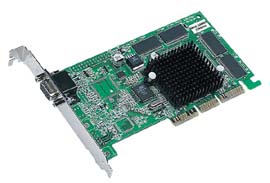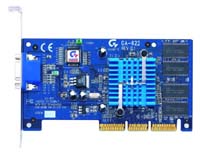The Cards
For this review, we received two TNT2 M64 samples – the Guillemot Maxi Gamer Cougar and the Gigabyte GA-622. Both these cards have different models from their regular TNT2 counterparts so they are easy to distinguish. However, Creative calls their M64 model the 3D Blaster TNT2 Value, which does not exactly scream out its true nature.
Unlike the Maxi Gamer Xentor 32, the Cougar runs at the NVIDIA recommended spec of 125/150 using a standard passive heatsink. SDRAM is of the 7ns variety from Mosel Vitalic on our sample. Expect this to be the typical configuration from most manufacturers.
Just as they did with the GA-660 and GA-660 Plus, Gigabyte has chosen not to follow the NVIDIA specs. Instead, they’ve gone with a heatsink on the chip itself as well as a heatsink mounted to the backside of the card. This allows them to also include their "turbo" jumper, which on the GA-622 sets the clock speed to 160/160. The default for non-turbo mode is the NVIDIA recommended 125/150.
It’s interesting to note that both cards were based on the NVIDIA reference board design, which is much smaller for the M64 than for the regular TNT2. Only four memory chips are necessary to fill the 64-bit memory bus, allowing the PCB to be smaller and cheaper. Even the board is much smaller, but there is still room on the board for TV-out and digital flat panel connectors and chips; however, it’s very unlikely that any manufacturers will be pursuing such options.
Overclocking
NVIDIA has always given manufacturers leeway in setting the clock speeds of their cards, as well as unofficially sanctioning overclocking sliders and utilities as a value added feature that manufacturers can use to distinguish themselves. Even the latest 3.47 Detonator drivers we received for evaluating the GeForce featured an overclocking utility. With all that in mind, it’s no surprise that the whole TNT2 series has been a prime candidate for overclocking.
With the M64, we had two cards to play with for this review – the Guillemot Cougar and the Gigabyte GA-622. Both used a very similar heatsink to cool the M64 chip itself. As mentioned above, the Gigabyte featured extra cooling in the form of a heatsink on the back of the card. As such, the GA-622 featuring a turbo jumper that boosted the speed to 160/160, a speed that is all but guaranteed for every GA-622 that comes off the line. Of course, we didn’t just settle for that and pushed further, eventually maxing out at 170/170. The Cougar was still fairly impressive, hitting 155/170 with its single heatsink. With both cards, it would be very easy to attach an old 486 fan to the standard heatsink and improve cooling, possibly allowing the cards to be pushed even further.
As always when overclocking, results will vary.












3 Comments
View All Comments